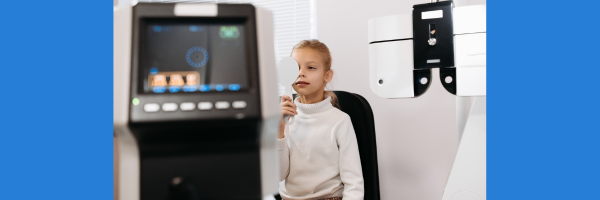More Green Time, Less Screen Time
Screen time has unavoidably become a big part of everyday learning and interaction, especially during the height of the coronavirus pandemic.
It has had huge benefits in helping us to communicate and stay in touch. However parents are often not aware of the association with low levels of outdoor activity and associated factors including low levels of light exposure and prolonged near tasks such as reading and screen time which may influence the development of myopia.
What is myopia?
Myopia (short-sightedness) is a common eye condition that causes blurred distance vision which usually starts during childhood and typically progresses until a child stops growing. Not only does myopia reduce the clarity of vision it also increases the risk of developing eye conditions later in life, some of which can cause permanent vision loss.
The importance of outdoor play
Lifestyle factors including low levels of outdoor activity may influence the development of myopia. More research is needed to determine if it is to do with the intensity or brightness of the light or the distances that children focus on, but what is proven is that there is a link between outdoor time and its benefit to a child’s myopia development.
Given that outdoor play is free, “more green time less screen time” is a timely reminder for moderation in an increasingly digital world.
What can parents do to help reduce the likelihood of their child developing myopia?
There are two main factors which can mean your child is more at risk of developing myopia: lifestyle and family history.
The likelihood of developing myopia, particularly high myopia increases when one or both parents are myopic. However, the exact link between a family history of myopia and development of childhood myopia remains uncertain.
You can’t influence genetics, but parents can feel empowered when it comes to lifestyle factors.
Top Three Myopia Busting Tips:
- More green time less screen time!
- Build in regular breaks from devices – every twenty minutes remind your child to have a break for at least twenty seconds and look out a window to something at least 6 metres away.
- Talk to your local optometrist about all of the options to stop your child from having to change glasses prescriptions as frequently.
The world after lockdown needs to include some thought on all aspects of how we live our lives. One thing that it has taught us all is that there needs to be a balance. We have embraced technology in a huge global experiment for how we work, now is an opportunity to extend that to how we want our children to grow up.
By 2050, it is estimated that more than 50% of the world’s population will have myopia and 10% or almost 1 billion will have high myopia. If we all encourage daily play time outdoors, we have an opportunity to halve that. Each time a prescription for short-sightedness increases in strength there is an increased association with serious eye conditions later in life, including an increased risk in permanent sight loss, however, action can be taken to manage myopia. Having regular eye examinations and starting a conversation with your optometrist is a positive first step.
Jagrut Lallu
Optometrist and founding member of the Australia and New Zealand Child Myopia Working Group



